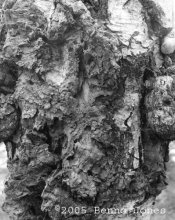bennoj
Member
Today was the big day... I had developed the film 2 weeks ago but circumstances prevented me from printing last week and earlier this week (damn job!), so today I headed into the darkroom with chemicals, printing frame, negatives, 300 watt lamp and a box each of Grade 2 and Grade 3 8x10 Azo.
The first order of business was setting up the printing area. I figured a way to attach the lamp housing onto one of the enlargers so that I could adjust the height as I needed. Screwed in the bulb, plugged it in and turned it on. Light! Great! Turned it off, got out the printing frame so I could mark the center of illumination, turned the lamp back on.... POP! One dead $25 floodlight bulb that had lasted all of 10 seconds & one decidedly not happy photographer.
So, off to Home Depot to see what kind of replacement I could get on short notice. I already knew they didn't have 300 watt R40's as I'd looked before I'd mail-ordered the first one. The best I could do was a 120 watt R40, so I figured I'd make do. Back to the darkroom, test the lamp... no problems. Sigh of relief from photographer.
Into the sink room to mix my developer, etc. No problems there except for nice black stains on my left hand because I forgot to put on gloves before opening the amidol. Hopefully it will wear off in a few days. Then finally I was ready to print!
I already knew that most of my negs were thinner than recommended for Azo printing, but figured with the lower wattage bulb they might be workable. I pulled the densest of my negs and got set up... now I came to a quandry... how long an exposure? I'm doing this totally on my own with no expert advice handy to look at my neg and say 'Hmmm try XX seconds on that one', so I just guessed blindly. 'I'll try 30 seconds and see what we get'. So 30 seconds of exposure and then into the dev... An image appears, it works! 1 minute in the dev, into the stop, into the fix... after 2 minutes in the fix I turn on the overhead and behold! My first Azo print! 30 seconds wasn't a bad guess but I did 2 more of that neg at 20 and 45 seconds to see how they look tomorrow morning when they're dry.
I worked through 5 negs and 13 prints with exposures ranging from 30 seconds to 3 seconds. The 150 watt lamp turned out to be just fine (I guess even my dense negs aren't dense enough). I'll try to scan a couple of the best to post tomorrow after I press them.
Yippee!
The first order of business was setting up the printing area. I figured a way to attach the lamp housing onto one of the enlargers so that I could adjust the height as I needed. Screwed in the bulb, plugged it in and turned it on. Light! Great! Turned it off, got out the printing frame so I could mark the center of illumination, turned the lamp back on.... POP! One dead $25 floodlight bulb that had lasted all of 10 seconds & one decidedly not happy photographer.
So, off to Home Depot to see what kind of replacement I could get on short notice. I already knew they didn't have 300 watt R40's as I'd looked before I'd mail-ordered the first one. The best I could do was a 120 watt R40, so I figured I'd make do. Back to the darkroom, test the lamp... no problems. Sigh of relief from photographer.
Into the sink room to mix my developer, etc. No problems there except for nice black stains on my left hand because I forgot to put on gloves before opening the amidol. Hopefully it will wear off in a few days. Then finally I was ready to print!
I already knew that most of my negs were thinner than recommended for Azo printing, but figured with the lower wattage bulb they might be workable. I pulled the densest of my negs and got set up... now I came to a quandry... how long an exposure? I'm doing this totally on my own with no expert advice handy to look at my neg and say 'Hmmm try XX seconds on that one', so I just guessed blindly. 'I'll try 30 seconds and see what we get'. So 30 seconds of exposure and then into the dev... An image appears, it works! 1 minute in the dev, into the stop, into the fix... after 2 minutes in the fix I turn on the overhead and behold! My first Azo print! 30 seconds wasn't a bad guess but I did 2 more of that neg at 20 and 45 seconds to see how they look tomorrow morning when they're dry.
I worked through 5 negs and 13 prints with exposures ranging from 30 seconds to 3 seconds. The 150 watt lamp turned out to be just fine (I guess even my dense negs aren't dense enough). I'll try to scan a couple of the best to post tomorrow after I press them.
Yippee!











 David
David